Posts Tagged ‘Zener diode’
Monday, November 19th, 2012
|
Last time we learned how the transistor opens a path for electric current to flow from the collector to the emitter in our example circuit. It does so by making use of an unregulated power supply. Now let’s see how the Zener diode fits into the mix.
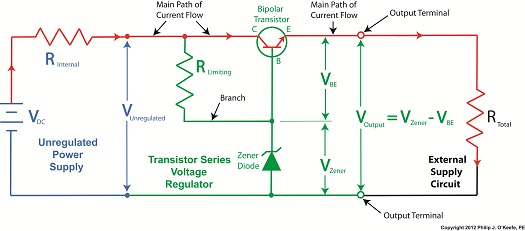
Figure 1
It just so happens that bipolar transistors, like the one in our example circuit in Figure 1, are designed so that voltage at its emitter is dependent upon the voltage applied at its base. This makes them ideal for use in voltage regulator circuits where this kind of predictability is required.
For example, in our transistor series voltage regulator, the Zener diode is connected to the transistor’s base, B. When the branch current flows from RLimiting down through the diode, a Zener voltage, VZener, is established. Since the diode is connected to the transistor, VZener voltage is also applied to the transistor’s base. Thus the transistor’s emitter voltage will be regulated according to the Zener voltage.
Bipolar transistors are designed by manufacturers to typically operate with a standardized voltage difference of 0.6 volts between the base and emitter. This is represented in Figure 1 as VBE, where BE stands for base-emitter. VBE is standardized at a known quantity of 0.6 volts to simplify things within the industry and aid engineers in their calculations to design transistor circuits, as we’ll now see.
With the Zener diode connected to the transistor base in our example circuit, the voltage difference is denoted as:
VBE = VZener – VE
where VE is the emitter voltage. Rearranging terms to solve for VE, we get:
VE = VZener – VBE
Inserting VBE, which we know is standardized at 0.6 volts:
VE = VZener – 0.6 volts
Since the emitter is physically connected to the output terminal of the transistor series voltage regulator, the emitter voltage is going to be equal to the output voltage, VOut.
We learned earlier in this series of articles that VZener is a reliable source of consistent voltage. Because it is present in our transistor series voltage regulator, our example circuit will produce a nice, constant regulated output voltage of VZener – 0.6 volts, a voltage that is useful for many of today’s applications. However the transistor series voltage regulator provides us with a major advantage over the Zener diode voltage regulator circuit.
The advantage of a transistor series voltage regulator lies in the fact that RLimiting is on a separate branch all to its own within the regulator circuit, and because of this it no longer acts as a roadblock to limit the main path of current flow, as happens within the Zener diode voltage regulator circuit discussed previously. Refer to the red path shown in Figure 1. With RLimiting in this position the transistor series voltage regulator is able to feed more current to the external supply circuit than is possible through the Zener diode voltage regulator alone. This means it can be used in more power hungry applications like energizing today’s TVs and modern kitchen appliances.
That wraps up our discussion on transistors. Next time we’ll begin a new topic, how medical devices can be designed using systems engineering, a systematic approach that ensures that designed devices satisfy both user and regulatory requirements.
____________________________________________
|
Tags: base, base emitter voltage, bipolar transistor, circuit, collector, electric current, electronics, emitter, emitter voltage, engineering expert witness, forensic engineer, kitchen appliance, output terminal, regulated output voltage, regulated power supply, resistor, transistor circuits, transistor series voltage regulator, TV, unregulated power supply, Zener diode, Zener Voltage
Posted in Engineering and Science, Expert Witness, Forensic Engineering, Innovation and Intellectual Property, Personal Injury, Product Liability | Comments Off on Transistors – Voltage Regulation, Final Chapter
Monday, November 12th, 2012
|
Last time we learned about a new type of transistor called a bipolar transistor and how it controls the flow of electric current traveling from the collector to the emitter within our circuit. We also saw how the bipolar transistor is integrated within a Zener diode voltage regulator circuit to make a new type of circuit called a transistor series voltage regulator.
Now let’s see how this all works by hooking our circuit up to both an unregulated power supply and an external supply circuit as shown in Figure 1.
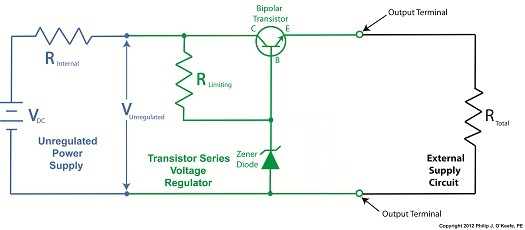
Figure 1
When voltage VUnregulated is applied to our transistor series voltage regulator circuit by way of an unregulated power supply, electric current flows through RLimiting into the base, B, of the transistor. The transistor senses this current and responds by opening a path for current to flow from its collector, C, to its emitter, E. With this path established, current flows freely from the unregulated power supply, through the transistor’s collector and emitter, on to the output terminal, and finally to the external supply circuit. Total resistance of this circuit is said to be RTotal.
At this point you’re probably wondering why the bipolar transistor base and Zener diode are connected to RLimiting. Next time we’ll conclude our series by seeing how this connection is crucial to the functionality of our transistor series voltage regulator.
____________________________________________
|
Tags: base, bipolar transistor, circuit, collector, emitter, engineering expert witness, forensic engineer, power, power supply, regulated voltage supply, resistor, transistor series voltage regulator, unregulated voltage supply, voltage regulation, Zener diode
Posted in Engineering and Science, Expert Witness, Forensic Engineering, Personal Injury, Product Liability | Comments Off on Transistors – Voltage Regulation Part XVII
Monday, November 5th, 2012
|
We’ve been discussing the Zener diode voltage regulator circuit, its advantages and disadvantages. We learned that the limiting resistor, RLimiting, creates a major disadvantage in the operation of the circuit, effectively acting as a roadblock to restrict current flow. Let’s see how to improve on that.
Figure 1 illustrates a transistor series voltage regulator circuit.
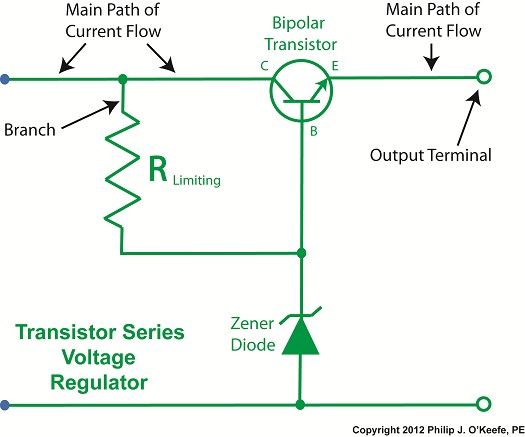
Figure 1
In this circuit the transistor is known as a bipolar transistor. Like the FET we discussed earlier, it has three electrical connections, however on the bipolar transistor the connections are referred to as the collector, base, and emitter. These are labeled C, B, and E in Figure 1.
The bipolar transistor acts as a valve, resting within the main path of current flow. That is, it controls the flow of electric current traveling from the collector to the emitter, as well as the voltage available at the emitter. The transistor is designed so that current flows in one direction only, from collector to emitter. We’ll talk more about that in our next article.
The limiting resistor, RLimiting, is located on a branch of the circuit leading to the Zener diode and the transistor base. Next time we’ll connect an unregulated power supply and external supply circuit to our transistor series voltage regulator. This will enable us to see how placing RLimiting on the branch, rather than along the main current path, results in a major advantage over using the Zener diode voltage regulator alone.
____________________________________________ |
Tags: base, bipolar transistor, circuit, collector, current flow, electric current, emitter, emitter voltage, engineering expert witness, FET, field effect transistor, forensic engineer, limiting resistor, power supply, regulated power supply, transistor series voltage regulator, transistors, voltage regulation, Zener diode
Posted in Engineering and Science, Expert Witness, Forensic Engineering, Innovation and Intellectual Property, Personal Injury, Product Liability | Comments Off on Transistors – Voltage Regulation Part XVI
Sunday, October 28th, 2012
|
We’ve been discussing the advantages of using limiting resistors within Zener diode regulating circuits to lessen the probability of circuit failure. Today we’ll continue our discussion, focusing on the Zener diode’s advantages and disadvantages. See Figure 1.
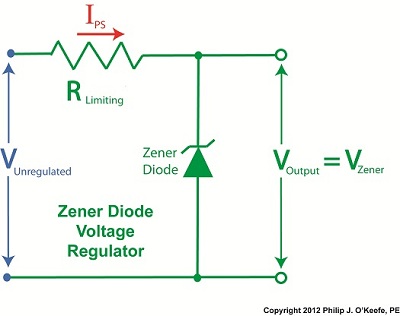
Figure 1
Figure 1 discloses the simplicity of a voltage regulator employing a Zener diode. There are only two components, a limiting resistor, RLimiting, and the Zener diode itself, which also makes the entire assembly cost effective to manufacture.
Despite the obvious advantages, there is one major disadvantage to the Zener diode voltage regulator. Ironically, the limitation imposed by RLimiting on the current IPS itself creates an operational dilemma. When electronic devices are connected to the output terminals of the regulator, RLimiting and its current-limiting action becomes a disadvantage. See Figure 2.
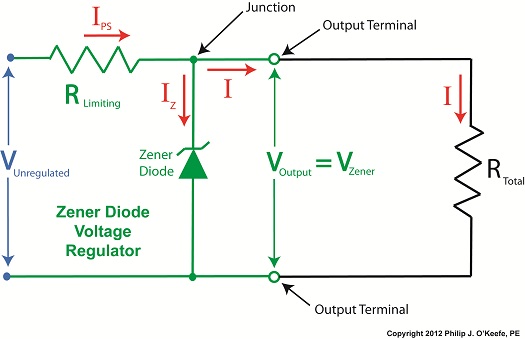
Figure 2
The amount of current I available to flow through to electronic devices is limited, sometimes too much, and the net result is that the Zener diode voltage regulator can only be used to power electronic devices drawing small amounts of current. It is unacceptable for many applications, such as powering kitchen appliances or flat screen TVs.
Next time we’ll see how to improve upon the Zener diode voltage regulator circuit by adding a transistor. This will eliminate the road block imposed by RLimiting, thus allowing higher, but still regulated, current to flow through to the output terminals.
____________________________________________ |
Tags: appliance, circuit failure, electric current, electronic devices, electronics, engineering expert witness, forensic engineer, output terminals, resistor, television, transistor, voltage regulator, Zener diode
Posted in Engineering and Science, Expert Witness, Forensic Engineering, Innovation and Intellectual Property, Personal Injury, Product Liability | Comments Off on Transistors – Voltage Regulation Part XV
Monday, October 22nd, 2012
|
As we’ve come to know through this series of blogs, all electronic components pose some degree of internal resistance to the electric current flowing through them. This resistance results in electrical energy being converted into heat energy, heat which poses potential problems to sensitive components like electronic circuit boards. If things get hot enough, components fail and fires may ignite.
To address these issues engineers design circuits with resistors whose job it is to limit the current flowing to electrical components. In this article we’ll see how a limiting resistor protects a Zener diode from this fate, allowing it to continue doing its job of regulating voltage.
In our last blog we applied Ohm’s Law to our regulated power supply circuit, which makes use of a Zener diode. See Figure 1.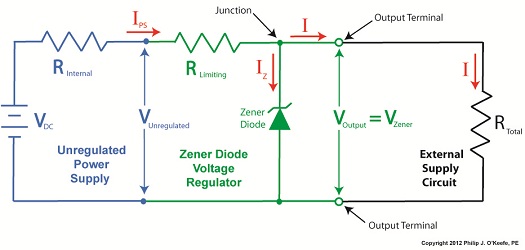
Figure 1
Ohm’s Law gave us the following equation to determine the amount of current, IPS, flowing from the unregulated power supply portion, through the current limiting resistor RLimiting, and making its way into the rest of the circuit:
IPS = (VUnregulated – VZener) ÷ RLimiting
We learned last week that for the circuit to work, the voltage of the unregulated power supply portion of the circuit, VUnregulated, must be greater than the Zener voltage, VZener.
Looking at the equation above, we see that the voltage difference is divided by RLimiting, the value of the limiting resistor in the circuit. This limiting resistor is there to constrain the current flowing to the Zener diode, allowing the diode to keep things under control within the circuit.
Basic mathematical principles hold that if a smaller number is divided by a bigger number, the resulting answer is an even smaller number. Applying this principle to the equation above, if RLimiting is a big number, then IPS must be a smaller number. On the other hand the smaller RLimiting gets, the bigger IPS becomes.
So what does it take for our circuit to fail? Remove the limiting resistor as shown in Figure 2 and the value for RLimiting disappears. In other words, RLimiting becomes zero.
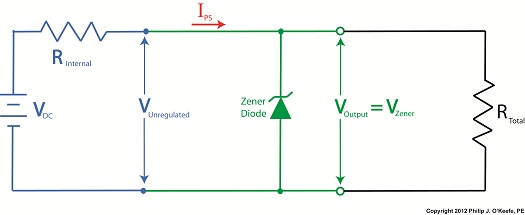
Figure 2
In this case our Ohm’s Law equation becomes:
IPS = (VUnregulated – VZener) ÷ 0 = ∞
The resulting answer is said to go to infinity, or ∞, as it is represented mathematically. In other words, without a limiting resistor being employed within our circuit, IPS will become so large it will overwhelm the diode’s current handling capacity and lead to circuit failure.
Next time we’ll go over some advantages and disadvantages of this Zener diode voltage regulating circuit, and why the disadvantages outweigh the advantages for many applications.
____________________________________________ |
Tags: circuit boards, circuit design, current capacity, electric current flow, electrical energy, electronic components, engineering expert witness, engineers, fires, forensic engineer, heat energy, internal resistance, limit current flow, Ohm's Law, power supply, unregulated power supply, voltage regulator, Zener diode
Posted in Engineering and Science, Expert Witness, Forensic Engineering, Innovation and Intellectual Property, Personal Injury, Product Liability | Comments Off on Transistors – Voltage Regulation Part XIV
Monday, October 15th, 2012
|
Last time we learned how the Zener diode, an excellent negotiator of current, is involved in a constant trade off, exchanging current for voltage so as to maintain a constant voltage. It draws as much current through it as is required to maintain a consistent voltage value across its leads, essentially acting as voltage regulator in order to protect sensitive electronic components from power fluctuations.
Now let’s revisit our example power supply circuit and see how Ohm’s Law is used to determine the amount of electric current, IPS, that flows from the unregulated power supply and why this is important to the function of the Zener diode. See Figure 1.

Figure 1
If you’ll recall, Ohm’s Law states that current flowing through a resistor is equal to the voltage across the resistor divided by its electrical resistance. In our example that would be IPS flowing through to RLimiting. In fact, the voltage across RLimiting is the difference between the voltages at each of its ends.
Applying this knowledge to our circuit, the voltage on one end is VUnregulated, while the voltage at the other is VZener. According to Ohm’s Law the equation which allows us to solve for IPS is written as:
IPS = (VUnregulated – VZener) ÷ RLimiting
And if we have a situation where VUnregulated equals VZener , such as when the voltage of an unregulated power supply like a battery equals the Zener voltage of a Zener diode, then the equation becomes:
(VUnregulated – VZener ) = 0
And if this is true, then the following is also true:
IPS = 0 ÷ RLimiting = 0
In other words, this equation tells us that if VUnregulated is equal to VZener, then the current IPS will cease to flow from the unregulated portion of the circuit towards the Zener diode and the external supply circuit. Put another way, in order for IPS to flow and the circuit to work, VUnregulated must be greater than VZener.
Next week we’ll continue our discussion and see why the resistor RLimiting is necessary in order to prevent the circuit from self destructing.
____________________________________________ |
Tags: battery, circuit, current, destructing, electric current, electronics, engineering expert witness, equation, forensic engineer, limiting resistor, Ohm's Law, power fluctuations, resistor, unregulated power supply voltage regulation, voltage, Zener diode
Posted in Engineering and Science, Expert Witness, Forensic Engineering, Innovation and Intellectual Property, Personal Injury, Product Liability | Comments Off on Transistors – Voltage Regulation Part XIII
Sunday, October 7th, 2012
|
Let’s continue our discussion with regard to the example circuit discussed last time and see how the Zener diode works in tandem with the limiting resistor to control current flow and hold the output voltage at a constant level.

Figure 1
To recap our discussion from last week, the unregulated power supply portion of the circuit in Figure 1 generates an unregulated voltage, VUnregulated. Then the Zener diode, which acts as a voltage regulator, takes in VUnregulated and converts it into a steady output voltage, VOutput. Because these output terminals are connected to the ends of the Zener diode, VOutput is equal to the voltage put out by it, denoted as VZener.
The Zener diode, an excellent negotiator of current, is essentially involved in a constant trade off, substituting electric current that originates in the unregulated power supply portion of the circuit for voltage, VOutput, that will serve to power the external supply circuit. In other words, the Zener diode draws as much current, IZ, through it as it needs, its objective being to keep VOutput at a constant level, and it will continue to provide this constant output, despite the fact that VUnregulated varies considerably.
So, where does the current IZ come from? From IPS, that is, the current flowing from the unregulated power supply area, as shown in Figure 1.
IPS flows through the limiting resistor to a junction within the circuit. At this junction, IZ splits off from IPS and continues on to the Zener diode, while current I splits off from IPS on its way to the total internal resistance, RTotal, in the external supply circuit.
What this means is that when you add IZ and I together, you get IPS. Mathematically speaking this is represented as:
IPS = IZ + I
Why solve for IPS? We’ll see why this is important when we revisit Ohm’s Law next week and gain a fuller understanding of how IPS, VUnregulated, VZener, and RLimiting relate to each other with regard to the Zener diode.
____________________________________________ |
Tags: circuit, constant voltage, current flow, diode, electronic, engineering expert witness, forensic engineer, internal resistance, junction within the circuit, limiting resistor, Ohm's Law, output terminals, output voltage, resistor, unregulated power supply, voltage regulator, Zener diode
Posted in Engineering and Science, Forensic Engineering, Innovation and Intellectual Property, Personal Injury, Product Liability | Comments Off on Transistors – Voltage Regulation Part XII
Monday, October 1st, 2012
|
Without limits on our roadways things would get quickly out of hand. Imagine speeding down an unfamiliar highway and suddenly coming upon a sharp curve. With no speed limit sign to warn you to reduce speed, you could lose control of your car. Limits are useful in many situations, including within electronic circuits to keep them from getting damaged, as we’ll see in a moment.
Last time we introduced the Zener diode and the fact that it performs as a voltage regulator, enabling devices connected to it to have smooth, uninterrupted operation at a constant voltage. Let’s see how it works.

Figure 1
In Figure 1 we have an unregulated power supply circuit introduced in a previous article in this series. We learned that this power supply’s major shortcoming is that its output voltage, VOutput, is unregulated, in other words, it’s not constant. It varies with changes in the direct current supply voltage, VDC.
It also varies with changes in, RTotal, which is the total internal resistance of components connected to it. RTotal changes when components are turned on and off by microprocessor and digital logic chips. When VOutput is not constant, those chips can malfunction, causing the device to operate erratically or not at all.
But we can easily address this problem by adding a Zener diode voltage regulator between the unregulated power supply and the external supply circuit. See the green portion of Figure 2.
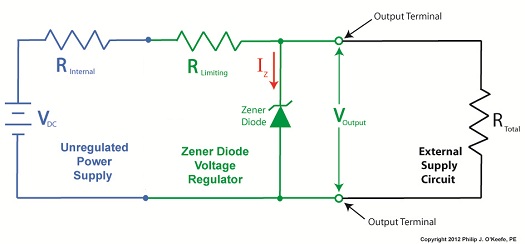
Figure 2
Our power supply now consists of a Zener diode and a limiting resistor, RLimiting. The limiting resistor does as its name implies, it limits the amount of electric current, IZ, flowing through the Zener diode. Without this limiting resistor, IZ could get high enough to damage the diode, resulting in system failure.
Next time we’ll see how the Zener diode works in tandem with the limiting resistor to control current flow and hold the output voltage at a constant level.
____________________________________________ |
Tags: circuit, constant voltage, current flow control, damage, digital logic chip, diode, direct current supply, electric current, electronic circuits, electronics, engineering expert witness, forensic engineer, internal resistance, limiting resistor, microprocessor, output voltage, regulated power supply, system failure, transistor, unregulated power supply, voltage regulator, Zener diode
Posted in Engineering and Science, Expert Witness, Forensic Engineering, Innovation and Intellectual Property, Personal Injury, Product Liability | Comments Off on Transistors – Voltage Regulation Part XI
Monday, September 24th, 2012
| Through the ages it’s been common practice to name important discoveries after those who discovered them. For example, James Watt was a mechanical engineer who improved the steam engine by finding a solution to the problem of steam condensing into water inside the engine, a phenomenon which resulted in the engine cooling and reducing its efficiency. Thus it was fitting that a metric unit of power, the watt, was named in his honor. Today we’ll become acquainted with the man behind the naming of the Zener diode, Clarence Zener, and take a look at his contributions with regard to the function of this electrical component.
Last time we began our discussion on electrical components known as diodes and saw how they’re used on circuit paths to govern the flow of current. The Zener diode is a particular type of diode and a key component in transistorized voltage regulator circuits, as we’ll see later. For now, let’s see how it works. The symbol for the Zener diode is almost identical to that of a standard diode, introduced in my previous blog, but the Zener version has a bent line going through it resembling a distorted letter “z.” See Figure 1.
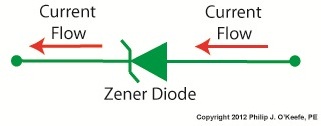
Figure 1
Electric current flows through the Zener Diode just as it does through a standard diode. But when the current flows in reverse, that’s where the similarity ends. See Figure 2.
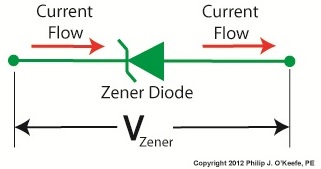
Figure 2
When current tries to flow in the reverse direction, the Zener diode acts as an electrical conductor and allows current to pass through it. In other words, it doesn’t block current flow as standard diodes do.
At this point, you may be asking, “What’s so special about that?” Perhaps you’ve made the connection that it behaves no differently than a metal wire. But that isn’t entirely correct.
You see, when current passes in the reverse direction through the Zener diode, it maintains a constant voltage. This is called the Zener Voltage and is denoted as VZener. The significance here is that within the circuit, any electronic component connected across the leads of a Zener diode will be supplied with a constant, unchanging voltage. Thus the Zener diode works as a voltage regulator, enabling devices connected to it to have smooth, uninterrupted operation at a constant voltage. It should be noted that this phenomenon only happens when the current flowing through the Zener diode is flowing in reverse.
Next time we’ll look at a basic regulated power supply circuit to see how a Zener diode is incorporated in order to maintain a consistent output voltage.
____________________________________________ |
Tags: circuit paths, Clarence Zener, current flow, diode, electrical components, electronics, engineering expert witness, forensic engineer, James Watt, output voltage, regulated power supply, reverse current flow, standard diode, steam engine, transistorized voltage regulator circuits, transistors, voltage, voltage regulator, Watt, Zener diode, Zener Voltage
Posted in Engineering and Science | Comments Off on Transistors – Voltage Regulation Part X
Sunday, September 16th, 2012
| One way streets frustrate me, and I usually end up wasting a lot of time and gas driving in circles to get to my destination. Generally speaking, I prefer a two way street. Electric current flowing through electronic circuits is somewhat analogous to traffic flow. There are circuit paths that act like one way streets and others that act like two-way.
An electrical component called a diode can be used on circuit paths to govern the flow of current. They are a key component in basic transistorized voltage regulator circuits, as we’ll see later. For now, let’s get a basic understanding of how they work.
Diodes are typically made of a semiconductor material, such as the element germanium. These materials behave in a complex way that fall along the lines of quantum physics. Esoteric phrases such as electron-hole theory, crystalline atomic lattice theory, and impurity doping are some of the concepts involved and would require a book onto themselves to explain. For the purposes of this article all we have to know is that semiconductors have two properties. The first property is that of an electrical conductor, that is, a material which allows electric current to pass through it. Copper wire is a good example of this. The second property is that of an electrical insulator, which blocks the flow of electric current. Materials such as glass, wood, and rubber fall into the insulator category.
A photo of a diode is shown in Figure 1, along with its symbol used in electrical schematics.
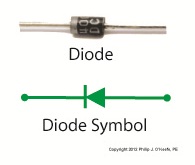
Figure 1
When electric current flows through a diode in one direction, as shown in Figure 2, the semiconductor material inside of it acts as a conductor, ushering it along a single path.
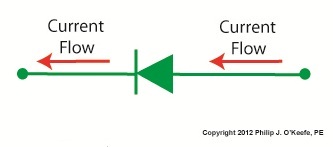
Figure 2
When current tries to flow through the diode in the reverse direction, the semiconductor material acts as an insulator. That is, it blocks the flow of current as shown in Figure 3.
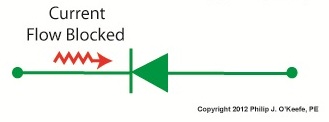
Figure 3
So we see that diodes can act like one way streets, restricting current flow. But, not all diodes work this way. Next week we’ll introduce a special kind of diode called the Zener diode, which allows current to flow in two different directions, and we’ll see how this functionality is put to work in regulated power supplies.
____________________________________________ |
Tags: circuit path, copper wire, current flow, diode, doping, electric circuit, electrical conductor, electrical insulator, electron-hole theory, electronics, engineering expert witness, forensic engineer, one way current flow, quantum physics, regulated power supply, semiconductor, transistorized voltage regulator circuits, Zener diode
Posted in Engineering and Science, Expert Witness, Forensic Engineering, Innovation and Intellectual Property, Personal Injury, Product Liability | 1 Comment »

















